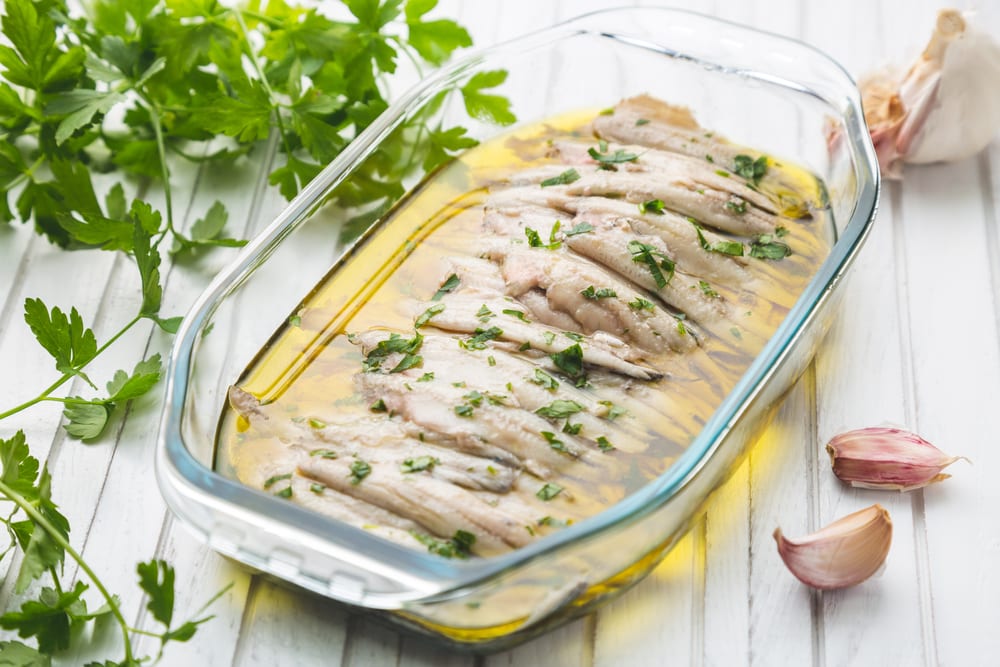
Anchovy is one of the most consumed fish and is known for its salty and fishy flavor. Honestly, many people think it’s overwhelming but it happens when you don’t know how to balance the flavor. Overall, it has a savory flavor with a higher amino acid level. In addition to fresh anchovies, anchovy paste is an easier version that can be easily added to different recipes for adding the fishy and umami flavor. So, if you want to know which is the better choice, we have anchovies vs anchovy paste comparison in this article!
Anchovies vs Anchovy Paste
Anchovy Paste
If you have tried anchovies before, there are chances that you’ve tried them in Caesar salad or in bucatini with tomato sauce. However, the anchovy paste is an easier form that’s available in jars and tins – it is made with a combination of anchovies, olive oil, and salt to make sure the flavor is optimized. The anchovy paste is available in toothpaste-like tubes and is likely to have a retro and neat design. The anchovy paste has become a handier option with a long-lasting formulation and an affordable price tag.
It wouldn’t be wrong to say that anchovy paste is slightly less salty as compared to fresh anchovies (this is salt is added to the paste). It easily dissolves into the dressing, soup, and sauce, resulting in a homogenous texture. It spreads pretty easily, which makes it easy to use for meat as you can rub it on the steak with olive oil. You can also mix it with the marinade that has garlic, shallots, and lime juice. As a result, it will bring out the robust and rich flavor of the meat.
The anchovy paste adds a hearty flavor to the stews and the salty flavor adds amazing character to the food. When it comes down to the shelf life, it’s available in cans or jars, so once they are opened, the paste will lose its freshness. Such paste lasts for a few minutes if you keep it in the refrigerator. In addition, less is more since the paste has a concentrated flavor and you won’t have to add more than one teaspoon. It tends to add a deeper flavor to the recipes and the smooth consistency promises proper cooking.
As far as the applications are concerned, it can be used in pasta e Ceci, canapes, and other Italian recipes. Overall, it is a fish paste that has anchovies as the primary ingredient and can be easily used as an ingredient or condiment, depending on the recipe. Anchovy paste is widely used in Italy, Vietnam, the Philippines, and the United Kingdom. The most unique fact is that the paste is made from Spanish anchovies, which is why it has a reddish-brown appearance with a pronounced umami flavor.
Anchovies
Contrary to anchovy paste, anchovies are basically silvery and small fish that are preserved in salt and are filleted – the filleted anchovies are added to the oil and are stored in jars or cans. The anchovies add a briny and salty flavor to an array of recipes, ranging from stir-fries to salad dressing. It is an oily fish with a briny and strong flavor – there is an abundance of umami flavor.
The anchovies are available in smoked as well as fresh forms. However, you can also find cured anchovies, which are cured in a vinegar solution. When comes down anchovies, can be used in pasta sauces, salad dressings, sandwiches, pizzas, crostini, soups, and other Asian dishes. The anchovies can be easily found in specialty markets, and grocery stores, and some online stores also have them in stock.
This fish tends to measure one inch to four inches. They are taken from the oceans, but in some cases, they can be found in the freshwater bodies. The whole anchovies are widely used in Spanish, Italian, and French cuisines since it has a fresh flavor. While they are commonly preserved in oil and sold in glass jars, you can also find them in pickled and dried forms.
The dried anchovies are commonly used in Korean cooking and make a great addition to stir-fried rice and soup. The anchovies are sold in jars and cans, ranging from two ounces to four ounces. However, you can also find them in clear trays in fresh form.